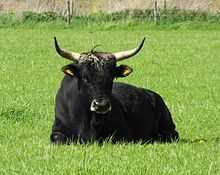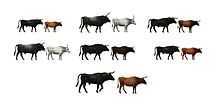TaurOs Project


TaurOs Project or Tauros Programme is a cooperation between the Dutch foundation Stichting Taurus and universities such as the Wageningen University and Research Centre. It is an international effort to breed a type of cattle which is, according to the responsible people, hoped to come as close as possible to the extinct aurochs, the wild ancestor of domestic cattle.
Tauros Project uses hardy cattle breeds with phenotypic resemblance to the extinct aurochs. By crossbreeding and selective breeding it tries to establish similarity to the aurochs. The longterm goal is to release these Tauros cattle into rewilding areas.
Background
Megaherbivores are considered important tools of nature conservation in maintaining the biodiversity of open or park-like landscapes without human interference. Therefore, it is planned to reintroduce large game in several reserves to recreate the natural dynamics of the European ecosystems. The aurochs was one of the most important European ungulates, but was eventually wiped out in 1627. Thus, so-called rewilding has to work with its domesticated descendants, of which several breeds are hardy and robust enough to fill this gap. In many grazing projects, especially in Germany, Heck cattle is used, together with Galloways and Highland cattle. Heck cattle originated in the 1920s, it was an attempt by Lutz and Heinz Heck to breed an aurochs look-alike from several cattle breeds. Heck cattle turned out to be a hardy breed, but is found to be considerably different from the aurochs in several aspects.[1]
TaurOs Project formed to achieve a breed of cattle which is closer to the aurochs than previous breeding back attempts. This is based on the idea that original features of the aurochs are still present in some, less-derived cattle breeds and can be re-united by crossbreeding and selective breeding to the largest possible degree. Stichting Taurus has been running grazing projects with hardy cattle and horses for years and bought numerous cattle breeds found to be authentic for the project from southern Europe.[2]
Methods and goal

TaurOs Project uses very hardy cattle breeds, which should preferably resemble the aurochs to a useful extent. Crossbreeding and selective breeding with such breeds should create new lineages which are hoped to come close to the aurochs as much as possible and are fit for being released in European wild reserves. Not only the phenotype and robustness are in the focus of breeding, but also genetic information of the aurochs which might be preserved in these breeds is considered. There are variations within each breed, so a very rigorous selection criteria is necessary to select the individuals that are included on the project. Accordingly, studies are running parallel under the umbrella of the project, e.g., to evaluate possible introgression of wild aurochs into the European cattle population. Furthermore, the food choice and behaviour of the used breeds is examined.[3]
The breeds which are used for crossbreeding mostly stem from the Iberian Peninsula and Italy. For example, these are Sayaguesa Cattle, Pajuna Cattle, Italian Podolica and Maremmana primitivo. Especially Pajuna and Podolica are deemed to be genetically very close to the Aurochs. Although genetically very close to the Auroch as well the Lidia breed (Spanish fighting bull) was not used for the project due to its aggressive behaviour.[4] These primitive breeds decreased in numbers during the last decades, some are highly endangered. Scottish highland cattle is used as well, because this breed has a long and dense coat and is very hardy. Several cross individuals have been born already.[5]
It is expected that there will be about 100 animals by 2015. According to Wouter Helmer, the resulting aurochs-like cattle will be able to move freely in wild herds in the near future and belong to the European nature just as red deer, wild boar, and wolves.[6][7]
Meanwhile, the genetic relationship between the cattle breeds and the aurochs is examined.[8]
Breeds in use and present crossbreeding results

Following robust cattle breeds with an overall very primitive phenotype are presently used:
- Sayaguesa Cattle
- Maremmana primitivo
- Pajuna Cattle
- Limia Cattle
- Maronesa
- Podolica
- Highland Cattle
Several crossbred individuals have been born already, the oldest in 2010. A young bull which is the result of crossing Maremmana primitivo with Pajuna, two tall and long-legged breeds, already has the colour characteristics of the aurochs, having a black colour with a light eel stripe and a mealy mouth.[9] Early in 2013, there were 120 cross individuals, some of them belong to the second generation already.[8]
-
Maronesa cow in Keent
-
Young Sayaguesa bull
-
Maremmana x Highland (cow)
-
Sayaguesa cross cow
-
Podolica cow
-
Sayaguesa cow
-

Young Maronesa bull before being released
Locations
Netherlands: Several Tauros herds are found in the Netherlands, such as the Keent reserve,[10] Kempen-Broek,[11] and Park Lingenzeegen.[12]
Portugal: A new herd was set up starting with Maronesa in Faia Brava.[13]
Croatia: Approximately another herd is going to be set up in Velebit.[14]
See also
References
- ↑ Cis Van Vuure (2005). Retracing the Aurochs: History, Morphology & Ecology of an Extinct Wild Ox. Pensoft Pub. ISBN 954-642-235-5.
- ↑ "Project TaurOs || Stichting Taurus". Stichtingtaurus.nl. Retrieved 2012-03-10.
- ↑ "The Aurochs is coming back to European forests and grasslands | European WILDLIFE". Eurowildlife.org. Retrieved 2012-03-10.
- ↑ "2012 – when the Tauros started growing wings". rewildingeurope.com. Retrieved 2012-04-09.
- ↑ "Nieuws || Stichting Taurus". Stichtingtaurus.nl. Retrieved 2012-03-10.
- ↑ "Website ark - Oerrund keert terug". Ark.eu. 2011-11-22. Retrieved 2012-03-10.
- ↑ "Uitgestorven oerrund komt terug naar Limburg". Gva.be. Retrieved 2012-03-10.
- ↑ 8.0 8.1 Ronald Goderie: 2012 – when the Tauros started growing wings. RewildingEurope.com-blog, 9. Januar 2013. Abgerufen am 14. März 2013 (englisch)
- ↑ Brabants Landschap: Het Taurus-rund op Keent. 2010.
- ↑ Stichting Taurus: „Nieuws. (Zoek: Keent).“ Abgerufen am 17. Juni 2013 (niederländisch)
Panoramio: „Project Tauros bij Keent.“ Abgerufen am 17. Juni 2013 (deutsch) - ↑ ARK Natuurontwikkeling: „TaurOs van start met toekomstig oerrund.“ Abgerufen am 17. Juni 2013 (niederländisch)
Stichting Taurus: „Nieuws. (Zoek: Kempen~Broek).“ Hierin insbesondere: „Nieuw terrein voor de Tauros in Kempen~Broek. 25-11-2012“. Abgerufen am 17. Juni 2013 (niederländisch)
Panoramio: „Tauros kalfje.“ Foto mit Karte und Koordinaten vom Standort Kempen-Broek. Abgerufen am 17. Juni 2013 (deutsch) - ↑ Stichting Taurus: „Eerste kruisingskalveren geboren. 28-04-2010.“ In: „Nieuws – Archief.“ Abgerufen am 17. Juni 2013 (niederländisch)
- ↑ Stichting Taurus: „Portugese Maronesarunderen in Keent. 09-03-2013.“ In: „Nieuws – Archief.“ Abgerufen am 17. Juni 2013 (niederländisch)
- ↑ Stichting Taurus: „ Een nieuwe locatie voor Taurossen in Kroatië?. 08-03-2013.“ In: „Nieuws – Archief.“ Abgerufen am 17. Juni 2013 (niederländisch)
External links
| Wikimedia Commons has media related to TaurOs Project. |





